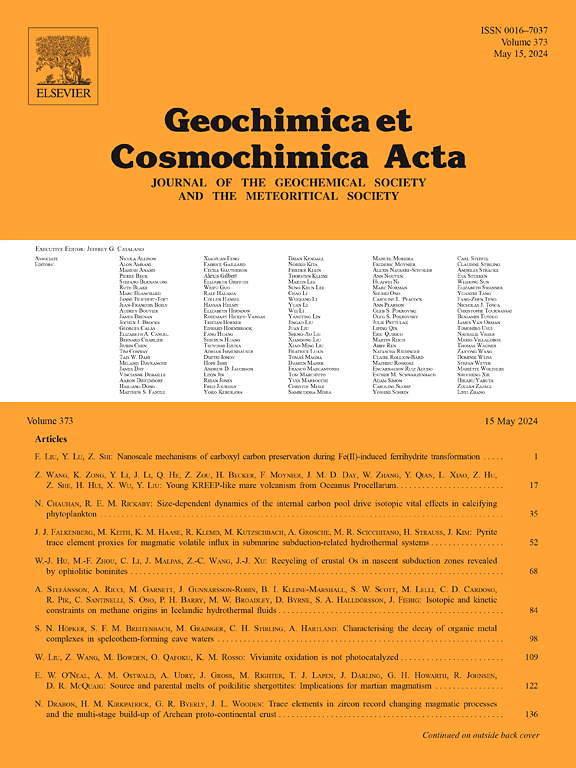Uranium reduction in modern and ancient marine carbonate settings – insights from anaerobic U extractions and high-energy resolution X ray spectroscopy
IF 5
1区 地球科学
Q1 GEOCHEMISTRY & GEOPHYSICS
引用次数: 0
Abstract
In the marine environment, hexavalent uranium, U6+, is incorporated into primary carbonate minerals with the same isotopic composition (δ238U) as the seawater in which they are formed. Yet, modern marine carbonate sediments carry heavier U isotope compositions. This enrichment of heavy U isotopes has been linked to biogenic U reduction in and below the Fe-reducing zone inside the sediment. Still, the oxidation state(s) of uranium in marine carbonate sediments undergoing syndepositional diagenesis has never been measured before. Here, we 1) present an anaerobic ion chromatographic technique based on the TEVA® resin to chemically separate and quantify abundances of tetravalent U4+ and hexavalent U6+ fractions in the carbonate, and 2) compare the results from ion chromatography to U L3 edge HERFD-XANES spectroscopic measurements of the total U in sediments to 3) estimate U oxidation states of fresh carbonate sediments from a modern seawater-fed lake and ancient limestones. We find that our anaerobic extraction technique can provide credible evaluations of reduced U4+ and oxidized U6+ contents, applicable to carbonate sediments and rocks. Our results show that U resides both in reduced and oxidized states in modern carbonate sediments and ancient carbonate rocks. By comparing air-exposed, oven-dried samples to samples always kept under strictly anaerobic condition, we find that the majority of authigenic U in modern carbonate sediments resides in oxidation-sensitive phases that accumulate with sediment depth, instead of being structurally bound in carbonate minerals (aragonite and calcite). We propose a model to account for the observed trends in U oxidation state, U phase associations, and U isotope fractionation, where a substantial fraction of U in the sediments is likely delivered via microbial reduction and precipitated as a non-crystalline, reduced form near the sediment–water interface. We suggest these oxidation-sensitive reduced U species participate in redox cycling where some U is re-oxidized and perhaps bio-reduced again later, for example in the presence of Fe(III) mineral surfaces that undergo reductive dissolution with depth. Simultaneously, a continued incorporation of recalcitrant and isotopically light (i.e. 238U-depleted) U from the pore fluids into diagenetic carbonate may occur. The determination of U oxidation states in modern carbonates in this study helps to bridge a gap in our knowledge of how U isotope signals are affected by syn-sedimentary diagenetic U transformations, opening new avenues for understanding sedimentary U cycling and improving the δ238U paleo redox proxy.
铀还原在现代和古代海洋碳酸盐设置-从厌氧U提取和高能分辨率 X 射线光谱学的见解
在海洋环境中,六价铀U6+被掺入原生碳酸盐矿物中,其同位素组成(δ238U)与形成它们的海水相同。然而,现代海相碳酸盐沉积物携带更重的U同位素组成。重铀同位素的富集与沉积物内铁还原带及其以下的生物源铀还原有关。然而,在同沉积成岩作用的海相碳酸盐沉积物中,铀的氧化态从未被测量过。在这里,我们1)提出了一种基于TEVA®树脂的厌氧离子色谱技术,用于化学分离和量化碳酸盐中四价U4+和六价U6+组分的丰度;2)将离子色谱结果与沉积物中总U的ul3边缘HERFD-XANES光谱测量结果进行比较;3)估计来自现代海水湖泊和古代石灰岩的新鲜碳酸盐沉积物的U氧化态。我们发现我们的厌氧萃取技术可以提供可靠的评价还原性U4+和氧化性U6+的含量,适用于碳酸盐沉积物和岩石。结果表明,铀在现代碳酸盐岩沉积物和古代碳酸盐岩中均以还原态和氧化态存在。通过将空气暴露、烘箱干燥的样品与严格厌氧条件下的样品进行比较,我们发现现代碳酸盐沉积物中的大部分自生铀存在于随沉积物深度积累的氧化敏感相中,而不是结构上结合在碳酸盐矿物(文石和方解石)中。我们提出了一个模型来解释观察到的U氧化态、U相关联和U同位素分馏趋势。其中沉积物中的大部分U可能通过微生物还原传递,并在沉积物-水界面附近以非结晶的还原形式沉淀。我们认为这些氧化敏感的还原U物种参与氧化还原循环,其中一些U被重新氧化,然后可能再次生物还原,例如在Fe(III)矿物表面存在的情况下,这些矿物表面会随着深度进行还原性溶解。同时,孔隙流体中的顽固性和同位素轻铀(即238u贫铀)可能继续掺入成岩碳酸盐中。本研究对现代碳酸盐岩中U氧化态的测定,有助于弥补我们对同沉积成岩U转化如何影响U同位素信号的认识空白,为理解沉积U旋回和改进δ238U古氧化还原代理开辟了新的途径。
本文章由计算机程序翻译,如有差异,请以英文原文为准。
求助全文
约1分钟内获得全文
求助全文
来源期刊

Geochimica et Cosmochimica Acta
地学-地球化学与地球物理
CiteScore
9.60
自引率
14.00%
发文量
437
审稿时长
6 months
期刊介绍:
Geochimica et Cosmochimica Acta publishes research papers in a wide range of subjects in terrestrial geochemistry, meteoritics, and planetary geochemistry. The scope of the journal includes:
1). Physical chemistry of gases, aqueous solutions, glasses, and crystalline solids
2). Igneous and metamorphic petrology
3). Chemical processes in the atmosphere, hydrosphere, biosphere, and lithosphere of the Earth
4). Organic geochemistry
5). Isotope geochemistry
6). Meteoritics and meteorite impacts
7). Lunar science; and
8). Planetary geochemistry.
 求助内容:
求助内容: 应助结果提醒方式:
应助结果提醒方式:


